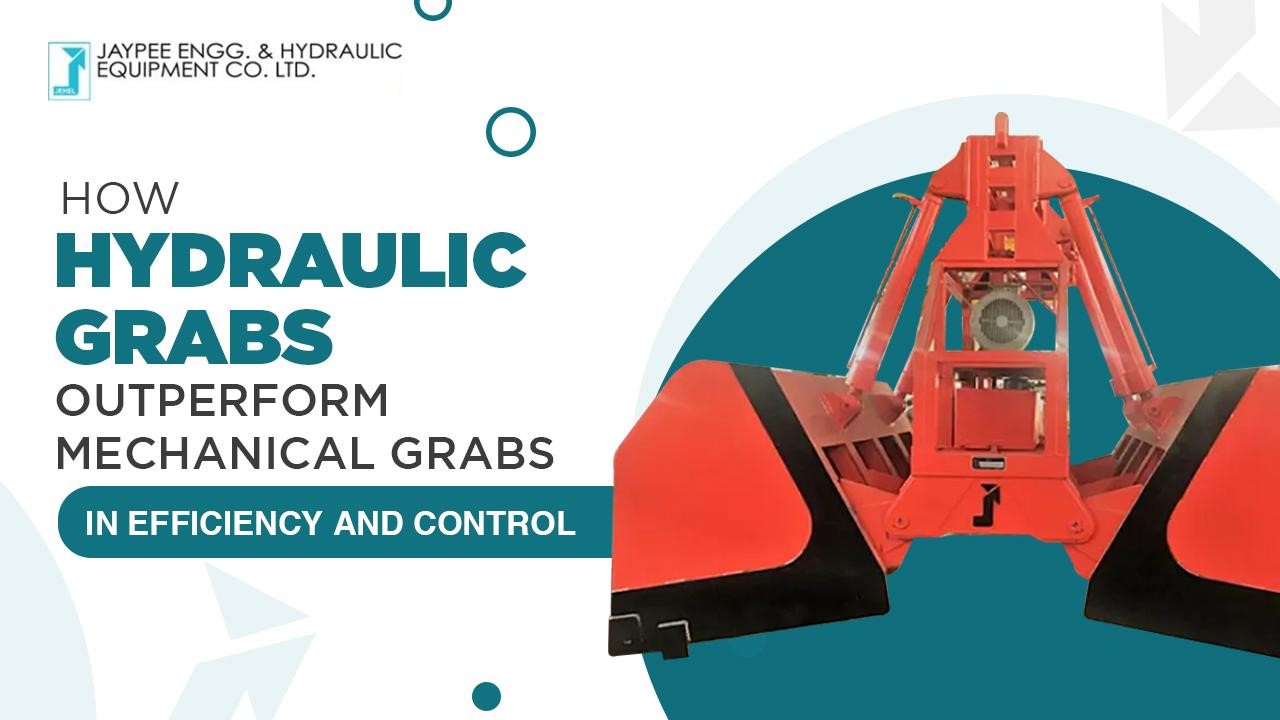Material handling efficiency and accuracy can make or break a facility’s production. A hydraulic grab can save maintenance costs by more than 50%, enhance operating efficiency by up to 73%, and minimize workplace incidents by 40% when a mechanical grab is replaced, according to research. Not only are these figures stunning, but they are transformative.
Due to its quicker cycles, more fluid control, and force adjustment, hydraulic grabs provide a clear advantage over traditional mechanical devices. This blog post will discuss how hydraulic grabs help operations remain safe and competitive by outperforming mechanical grabs in terms of speed, control, dependability, and overall performance.
What Makes them Different?
The main distinction comes from how each system delivers force and responds to operator commands.
A hydraulic grab uses pressurized oil to move cylinders, which open and close the jaws smoothly and precisely. This system delivers consistent force, allowing operators to handle heavy or delicate materials with accuracy. Adjustments in grip pressure are easy, giving flexibility across different types of loads.
A mechanical grab relies on cables, chains, and pulleys. Physical components pull and release to operate the jaws. While this design is durable and straightforward, it lacks the fine control and responsiveness of hydraulic systems.
These fundamental differences affect speed, safety, efficiency, and maintenance, making the choice of grab system crucial for any facility.
Speed and Productivity Benefits
Speed is important. The quicker each cycle, the greater the material you transport, and the greater your income.
Hydraulic grab systems cycle quickly. The jaws open and close in an instant. Placement is instantaneous. The movement is smooth and continuous.
Mechanical grabs are slower. Cables take time to wrap and unwind. Pulleys add friction and brief delays. On a full shift, these brief delays make a difference. A hydraulic system can cycle 45–50 per hour, while a mechanical grab does 35–40. That’s 120 fewer cycles a day for mechanical systems—a massive loss of productivity.
Control That Makes Operations Safer
Control is not precision—it’s safety. Operators require responsive equipment. Delay or hesitation can result in accidents.
Hydraulic grabs react immediately to operator commands. The command-action relationship is direct, providing operators with confidence and minimizing errors. You can even change gripping force mid-control, dealing with heavy scrap one moment and light goods the next.
Mechanical grabs offer fixed levels of force. The operators have little flexibility and need to make allowances for delays. The outcome is less accurate handling and greater potential for material damage.
Reliability You Can Rely On
Equipment failures occur when they’re least convenient: rush hours, emergency orders, or close deadlines. Reliability isn’t merely convenient—it’s necessary.
Hydraulic grab technology is reliable by nature. Fewer moving parts, strong cylinders, and good seal design make breakdowns unlikely and typically foreseeable.
Mechanical grabs have more moving parts. Cables age, bearings wear, and pulleys can break. Each is a threat to downtime. The expense of a single unplanned breakdown—lost production, idle employees, emergency service—can be thousands. Hydraulic grabs prevent these expensive interruptions.
Maintenance that Won’t Break the Bank
Regular maintenance counts. Hydraulic grabs demand fluid level checks, seal inspections, and filter changes. These are easy and routine tasks.
Mechanical grabs require continuous maintenance: cable checks, lubrication, tensioning, and wear-part replacement. Labor hours increase with maintenance time. These add up over months and years. Hydraulic grabs save not only in downtime but also in service labour.
Operating in Challenging Conditions
Not all facilities have optimum conditions. Extreme temperatures, freezing, or corrosive products are usual issues.
Hydraulic grabs perform under stressful conditions. Good fluid and sealed parts guarantee dependable function. Cables will become brittle in cold, expansion causes heat to ruin them, while moisture rusts them. Hydraulic systems are more resilient to environmental stress and endure longer.
Smart Financial Decision
Hydraulic grabs cost more initially, but that’s only half the story. Think in terms of overall ownership: installation, training, maintenance, energy, downtime, and productivity.
The cost savings build exponentially. Less maintenance, quicker cycles, and less downtime have most operations pay back the investment in 18–24 months. Then it’s sheer benefit. Mechanical grabs can save money up front, but their restriction and slower operations can end up being more costly in the long run.
Partner with JEHEL for Exemplary Solutions
Your plant deserves equipment as diligent as your workforce. JEHEL offers superior hydraulic grab solutions that optimize efficiency, safety, and control. We don’t sell equipment—humanely, we solve operational problems.
Our team assesses your specific requirements and suggests personalized solutions. Ready to feel the difference? Visit www.jehel.com today. Call us to find out how a hydraulic grab can revolutionize your material handling processes and boost your productivity.


